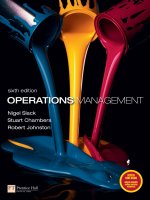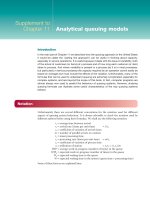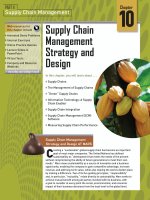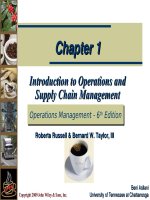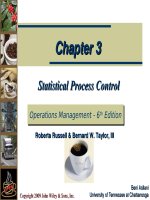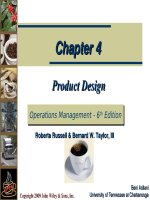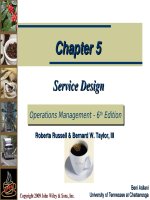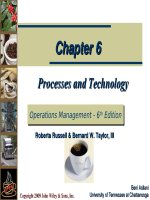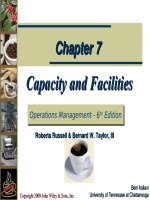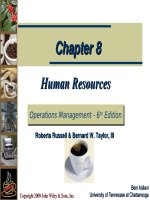Operation management 6e by russel and taylor ch01
Bạn đang xem bản rút gọn của tài liệu. Xem và tải ngay bản đầy đủ của tài liệu tại đây (561.5 KB, 42 trang )
Chapter 1
Introduction to Operations and
Supply Chain Management
Operations
Operations Management
Management -- 66thth Edition
Edition
Roberta Russell & Bernard W. Taylor, III
Copyright 2009 John Wiley & Sons, Inc.
Beni Asllani
University of Tennessee at Chattanooga
Lecture Outline
What Operations and Supply Chain
Managers Do
Operations Function
Evolution of Operations and Supply Chain
Management
Globalization and Competitiveness
Operations
Strategy and Organization of the Text
Learning Objectives for This Course
Copyright 2009 John Wiley & Sons, In
1-2
What Operations and
Supply Chain Managers Do
What is Operations Management?
design, operation, and improvement of productive
systems
What is Operations?
a function or system that transforms inputs into outputs
of greater value
What is a Transformation Process?
a series of activities along a value chain extending from
supplier to customer
activities that do not add value are superfluous and
should be eliminated
Copyright 2009 John Wiley & Sons, In
1-3
Transformation Process
Physical: as in manufacturing operations
Locational: as in transportation or
warehouse operations
Exchange: as in retail operations
Physiological: as in health care
Psychological: as in entertainment
Informational: as in communication
Copyright 2009 John Wiley & Sons, In
1-4
Operations as a
Transformation Process
INPUT
•Material
•Machines
•Labor
•Management
•Capital
TRANSFORMATION
PROCESS
OUTPUT
•Goods
•Services
Feedback & Requirements
Copyright 2009 John Wiley & Sons, In
1-5
Operations Function
Operations
Marketing
Finance and
Accounting
Human
Resources
Outside
Suppliers
Copyright 2009 John Wiley & Sons, In
1-6
How is Operations Relevant to my
Major?
“As an auditor you must
Accounting
understand the fundamentals of
operations management.”
“IT is a tool, and there’s no better
Information
place to apply it than in
Technology
operations.”
“We use so many things you
Management
learn in an operations class—
scheduling, lean production,
theory of constraints, and tons of
quality tools.”
Copyright 2009 John Wiley & Sons, In
1-7
How is Operations Relevant to my
Major? (cont.)
Economics
Marketing
Finance
“It’s all about processes. I live
by flowcharts and Pareto
analysis.”
“How can you do a good job
marketing a product if you’re
unsure of its quality or delivery
status?”
“Most of our capital budgeting
requests are from operations,
and most of our cost savings,
too.”
Copyright 2009 John Wiley & Sons, In
1-8
Evolution of Operations and
Supply Chain Management
Craft production
process of handcrafting products or
services for individual customers
Division of labor
dividing a job into a series of small tasks
each performed by a different worker
Interchangeable parts
standardization of parts initially as
replacement parts; enabled mass
production
Copyright 2009 John Wiley & Sons, In
1-9
Evolution of Operations and
Supply Chain Management (cont.)
Scientific management
systematic analysis of work methods
Mass production
high-volume production of a standardized
product for a mass market
Lean production
adaptation of mass production that prizes
quality and flexibility
Copyright 2009 John Wiley & Sons, In
1-10
Historical Events in
Operations Management
Era
Industrial
Revolution
Events/Concepts
Dates
Originator
Steam engine
Division of labor
Interchangeable parts
Principles of scientific
management
1769
1776
1790
James Watt
1911
Frederick W. Taylor
1911
Frank and Lillian
Gilbreth
Henry Gantt
Time and motion studies
Scientific
Management Activity scheduling chart
Moving assembly line
1912
1913
Copyright 2009 John Wiley & Sons, In
Adam Smith
Eli Whitney
Henry Ford
1-11
Historical Events in
Operations Management (cont.)
Era
Human
Relations
Operations
Research
Events/Concepts
Dates
Originator
Hawthorne studies
1930
1940s
1950s
1960s
1947
1951
Elton Mayo
Abraham Maslow
Frederick Herzberg
Douglas McGregor
George Dantzig
Remington Rand
1950s
Operations research
groups
1960s,
1970s
Joseph Orlicky, IBM
and others
Motivation theories
Linear programming
Digital computer
Simulation, waiting
line theory, decision
theory, PERT/CPM
MRP, EDI, EFT, CIM
Copyright 2009 John Wiley & Sons, In
1-12
Historical Events in
Operations Management (cont.)
Era
Events/Concepts Dates Originator
JIT (just-in-time)
TQM (total quality
management)
Strategy and
Quality
Revolution operations
Business process
reengineering
Six Sigma
1970s
1980s
1980s
1990s
1990s
Taiichi Ohno (Toyota)
W. Edwards Deming,
Joseph Juran
Wickham Skinner,
Robert Hayes
Michael Hammer,
James Champy
GE, Motorola
Copyright 2009 John Wiley & Sons, In
1-13
Historical Events in
Operations Management (cont.)
Era
Events/Concepts
Internet
Revolution
Internet, WWW, ERP,
1990s
supply chain management
E-commerce
Dates Originator
2000s
Globalization WTO, European Union,
1990s
and other trade
2000s
agreements, global supply
chains, outsourcing, BPO,
Services Science
Copyright 2009 John Wiley & Sons, In
ARPANET, Tim
Berners-Lee SAP,
i2 Technologies,
ORACLE
Amazon, Yahoo,
eBay, Google, and
others
Numerous countries
and companies
1-14
Evolution of Operations and
Supply Chain Management (cont.)
Supply chain management
management of the flow of information, products, and services across
a network of customers, enterprises, and supply chain partners
Copyright 2009 John Wiley & Sons, In
1-15
Globalization and
Competitiveness
Why “go global”?
favorable cost
access to international markets
response to changes in demand
reliable sources of supply
latest trends and technologies
Increased globalization
results from the Internet and falling trade
barriers
Copyright 2009 John Wiley & Sons, In
1-16
Globalization and
Competitiveness (cont.)
Hourly Compensation Costs for Production Workers
Source: U.S. Bureau of Labor Statistics, 2005.
Copyright 2009 John Wiley & Sons, In
1-17
Globalization and
Competitiveness (cont.)
World Population Distribution
Source: U.S. Census Bureau, 2006.
Copyright 2009 John Wiley & Sons, In
1-18
Globalization and
Competitiveness (cont.)
Trade in Goods as % of GDP
(sum of merchandise exports and imports divided by GDP, valued in U.S. dollars)
Copyright 2009 John Wiley & Sons, In
1-19
Productivity and
Competitiveness
Competitiveness
degree to which a nation can produce goods and
services that meet the test of international
markets
Productivity
ratio of output to input
Output
sales made, products produced, customers
served, meals delivered, or calls answered
Input
labor hours, investment in equipment, material
usage, or square footage
Copyright 2009 John Wiley & Sons, In
1-20
Productivity and
Competitiveness (cont.)
Measures of Productivity
Copyright 2009 John Wiley & Sons, In
1-21
Productivity and
Competitiveness (cont.)
Average Annual Growth Rates in Productivity, 1995-2005.
Source: Bureau of Labor Statistics. A Chartbook of
International Labor Comparisons. January 2007, p. 28.
Copyright 2009 John Wiley & Sons, In
1-22
Productivity and
Competitiveness (cont.)
Average Annual Growth Rates in Output and Input, 1995-2005
Source: Bureau of Labor Statistics. A Chartbook of International
Labor Comparisons, January 2007, p. 26.
Copyright 2009 John Wiley & Sons, In
Dramatic
Dramatic Increase
Increase in
in
Output
Output w/
w/ Decrease
Decrease in
in
Labor
Labor Hours
Hours
1-23
Productivity and
Competitiveness (cont.)
Retrenching
productivity is increasing, but both output and input
decrease with input decreasing at a faster rate
Assumption that more input would cause
output to increase at the same rate
certain limits to the amount of output may not be
considered
output produced is emphasized, not output sold;
increased inventories
Copyright 2009 John Wiley & Sons, In
1-24
Strategy and Operations
Strategy
Provides direction for achieving a mission
Five Steps for Strategy Formulation
Defining a primary task
Assessing core competencies
What qualifies an item to be considered for purchase?
What wins the order?
Positioning the firm
What does the firm do better than anyone else?
Determining order winners and order qualifiers
What is the firm in the business of doing?
How will the firm compete?
Deploying the strategy
Copyright 2009 John Wiley & Sons, In
1-25
